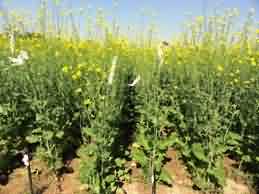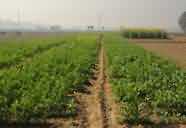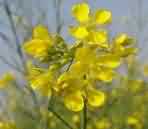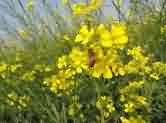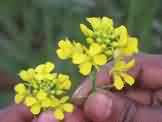सरसों (रेपसीड) की संकर बीज उत्पादन करने की तकनीक
The potential of the conventionally bred open pollinated varieties has been exploited to its maximum level resulting in a platue in the productivity level, which breeder often calls as yield stagnancy. Here we need to exploit the heterosis i.e. hybrid vigour to break the yield platue. Three hybids, namely NRCHB 101, NRCHB 506 and
Dhara mustard hybrid-1 were released in 2008. Development of a successful hybrid seed production technology in a crop is essential for the extension of hybrid technology to farmers. Standardization of sowing time and planting ratio is an important aspect for economic hybrid seed production and it is more valid for a species, which is predominantly self- pollinated. A higher frequency of male rows in a planting ratio sown at optimum time gives higher hybrid seed set in Indian mustard.
HSP plot with 8:2 row ratio Hybrid seed production block
A successful hybrid seed production technology depends mainly on maintenance of its parental lines at highest purity.
Maintenance of parental lines/nucleus seed production
CMS is sown in seed multiplication plot along with its maintainer (B-line) in 4: 2 ratio just like hybrid seed production plot. In order to have high pollen pressure, planting may be 3: 2 or 1: 1 if pollen parent is poor pollen production. The B-line is male fertile and is genetically similar to CMS (A-line) expect that its cytoplasm is fertile. The seed harvested on A-line is used for A-line seed multiplication and as female parent for hybrid seed production. As rapeseed-mustard is prone to shattering, B-line plants should be harvested just after the completion of pod setting on A-line to avoid seed admixture of A-line and B-line. Proper isolation distance (1500 m) from other Brassica field needs to be maintained to ensure purity of A-line. The maintenance of A-line depends on genetic purity of B-line, hence utmost care is needed for its purity. Since maintainer or B-line is self-fertile, it is multiplied through open-pollination in an isolation of 2000 m. Off-type plants should be removed before flowering so as to ensure its genetic purity and therefore of A-line. Restorer or R-line carries male fertility restorer genes and is self-fertile. It is maintained just like B-line by open-pollination in an isolation of 2000 m.
Breeder and foundation seed production of Mustard
Breeder seed is a progeny of nucleus seed. In breeder seed production three different lines, CMS lines, maintainer line (B), and restorer line (R) should have to multiply in different isolated (isolated 2000 meters) fields.
CMS line
The seed parent (A-line) is grown with its maintainer (B-line) in 4: 2 ratio. In order to have high pollen pressure two-four border rows of B-line all around the field may be grown. Border rows should be grown from the same seed lot of B-line, which was used for main plot as male parents.
The second method is to grow four to five rows of each A-line and B-line (row distance 30 cm) which gives strips of 1.2-1.5 m (Frauen 1987). The fields must have absolutely no volunteer brassica plants. Adequate visits of honey bees to the seed parents A-line and B-line have to be ensured. B-line should have to harvest just after flowering period is over.
B- and R-line
B- and R-line are self-fertile and may be multiply by open pollination in an isolated field (200 meters). In production of breeder seed three line gap should be kept after every 6-7 lines to facilitate inspection of the crop by breeders and monitoring team. The roguing should be carried out at three stages. The off-type plants distinguishable on the basis of morphological characteristics should be removed before flowering. The seed crop should be sown in wide rows (42-45 cm) to permit roguing. Careful roguing is required at all stages of crop growth and development. During roguing special attention is required to remove objectionable weed. In mustard crop, Mexican prickly poppy (Argemone mexicana) is designated as objectional weed. This weed is commonly known as satyanasi in northern part of India.
Synchronised flowering of male and female parents in Mustard
Oilseed brassicas have indeterminate flowering habit. Early onset of flowering in the female parent as compared to the pollen parents invariably results in female plants getting taller. This reduces the hybrid seed set as the access of the pollen to the stigma is reduced. Detopping of alternate plant of male parent (in 2M : 4F/2M : 6F) ratio coupled with additional application of N (@ 25 kg/ ha) between pollinator rows after flowering was found effective to ensure pollen supply for longer duration.
Fig: Flower morphology Fig: Honeybee foraging Fig: female (left) and male flower
Hybrid Production technology:
1. Climate: Requires cool, moist climate for seed production. It can be grown in northern hills and plains
2. Sowing time: Second half of October
3. Land requirement: At least for previous three years no rapeseed-mustard crop. Land should be free of volunteer plants. It should be deep, fertile, well drained, light-to-medium textured and high in organic matter
4. Isolation requirement: 1500 meters from the fields of the other oilseed rape, same hybrid not conforming to parental line purity requirements and from the varieties belonging to genera Brassica
5. Seed treatment: Thiram -3 g/kg of seed or Bavistin -2 g/kg seed
6. Seed rate:
- Female line: 1875 g/ha
- Male line: 875 g/ha
7. Sowing of seeds:
- Seeds are sown in furrows 7-8cm apart.
- Depth of sowing: 2.5-3.0 cm
8. Planting ratio: 8: 2 (female: male, more or less female rows may be used as per pollen productivity of male line)
9. Spacing: Row to row: 30 cm, Plant to plant: 20 cm
10. Manure & Fertilizer:
- FYM 20-25 tonnes/ha
- N: P: K. - 100: 60: 40 kg/ha, apply N in split
11. Irrigation: Frequent light irrigation till pod setting, in shortage of irrigation, two at pre-boom and one at pod filling stage
12. Roguing:
- Reject/ remove off-types at pre-flowering stage and diseased plants
- Remove objectionable weed plants (Satyanashi)
- At least three field inspection at pre-flowering, flowering and pre-harvest stage
13. Keep honeybee hives: 5-10 behives per hactre
14. Harvesting: Male line is harvested first followed by female line when siliqua are mature and attain yellow colour
15. Seed yield: 2-2.5 t/ha
Field Standards for HSP in Mustard
For seed quality control, certain field and seed standards are essential, which should strictly be followed during seed production and subsequent seed processing. Till now, field and seed standards have not been standardised for hybrid mustard seed production. Still we can follow the standards recommended for open pollinated varieties in Indian Minimum Seed Certification Standards (IMSCS) by Trivedi & Gunasekaran, 2013 (yet to publish) to maintain the seed purity and quality of hybrid mustard.
A. General requirements
Isolation
Seed fields shall be isolated from the contaminants shown in column 1 of the Table below by the distances specified in column 2 and 3 of the said Table:
|
Contaminants |
Minimum distance (meters) |
|||
|
Foundation |
Certified |
|||
|
Self-Compatible types |
Self- Incompatible types |
Self- Compatible types |
Self-Incompatible type
|
|
|
1 |
2 |
3 |
4 |
5 |
|
Fields of the other hybrids of same parental lines of the same spp. |
200 |
100 |
50 |
50 |
|
Fields of the same (parental lines) not conforming to varietal purity requirements for certification |
200 |
100 |
50 |
50 |
|
Fields of Rocket salad and any of the other species of the genus Brassica |
50 |
100 |
25 |
50 |
B. Specific requirements
|
Factor |
Maximum permitted (%)* |
|
|
Foundation |
Certified |
|
|
Off-types |
0.10 |
0.50 |
|
**Objectionable weed plants |
0.050 |
0.10 |
*Maximum permitted at any inspection conducted at and after flowering in the case of off-types and the final inspection in case of objectionable weeds.
**Objectionable weed shall be: Mexican prickly poppy (Satyanashi- Argemone mexicana L.)
Seed Standards of Mustard
|
Factor |
Maximum permitted(%)*
|
|
|
Foundation |
Certified |
|
|
Pure seed (minimum) |
97.0% |
97.0% |
|
Inert matter (maximum) |
3.0% |
3.0% |
|
Other crop seeds (maximum) |
10/kg |
20/kg |
|
Other distinguishable varieties (maximum) |
0.10% (by number) |
0.50% (by number) |
|
Total weed seeds (maximum) |
10/kg |
20/kg |
|
*Objectionable weed seeds (maximum) |
5/kg |
10/kg |
|
Germination (minimum) |
85% |
85% |
|
Moisture (maximum) |
8.0% |
8.0% |
|
For vapour-proof containers (maximum) Mustard Rapeseed |
|
|
|
5.0% |
5.0% |
|
|
7.0% |
7.0% |
|
*Objectionable weed is the same as given at B above.
Seed storage
Mustard seeds exhibit fairly good storability under ambient condition of mild climate maintaining germination (85%) for at least two planting season recommended in IMSCS. However, hybrid seed being high value commodity, germination and vigour of the seed need to be maintained as high as possible. For this reason, hybrid mustard seeds are dried below 7-8% moisture and stored in sufficiently cool, dry and hygienic ambience.
ACKNOWLEDGEMENT:
Facilities provided by Division of Seed Science and Technology, Indian Agricultural Research Institute, New Delhi during standardisation of this method is duly acknowledged.
Authors:
Aniruddha Maity1* and S. K. Chakrabarty2
1Seed Technology Division, Indian Grassland and Fodder Research Institute, Jhansi, UP- 284003.
2National Fund for Basic, Strategic and Frontier Application Research in Agriculture, 707, Krishi Anusadhan Bhavan-I, Pusa, New Delhi- 110012.
*Email:

